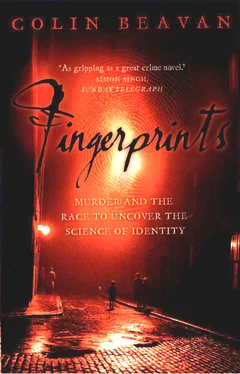Briggs’s son informed Detective-Inspector Dick Tanner, who investigated the case, that Briggs’s gold watch, chain, and eyeglasses were missing from his personal effects. The bag and the stick found in the carriage belonged to Briggs, the son reported, but the low-crowned black beaver hat did not. Briggs habitually wore tall hats. Tanner presumed the beaver hat to belong to the murderer and it was his only clue.
Tanner circulated to every jeweler and pawnbroker a description of Briggs’s missing jewelry, in the hope that they might lead to the murderer. He also visited the manufacturers of the hat—J. H. Walker of Marylebone—but they did not know to whom they’d sold it. The already meager trail of clues had narrowed to nothing. Then a jeweler named Death contacted the Yard in response to the circular.
Two days after the murder, Mr. Death recalled, a thin, sallow-faced man, a German, had exchanged a gold chain matching the description on the circular for a ring and another chain bearing a different pattern. In a second stroke of luck, a cabman named Mathews, hearing the case details discussed in a pub, remembered that he had seen a jeweler’s box bearing the name Death in the room of his former lodger, a German by the name of Franz Muller. Mathews identified the hat found in the carriage as Muller’s, and gave Tanner a photograph of the suspect along with the news that he had embarked on a sailing ship headed for New York.
Muller’s ship, the sailing vessel Victoria , would not reach port for six weeks. Muller had five days’ start, but there was ample time to overtake him by steamship. Tanner took the train to Liverpool, embarked, and landed in New York long before the sailing ship was due. On the appointed day, Tanner and a New York City policeman rowed out to the Victoria in a small boat as it came into New York harbor. They searched Muller’s cabin and found Briggs’s watch and hat. Muller was brought back to London and tried.
Only physical evidence—the jewelry and the hat—connected Muller to the dead man. A hundred and fifty years earlier, with no eyewitnesses, a prosecution would have been impossible. But the law had evolved. The judge at Muller’s trial explained the use of modern evidence to the jury: “One may describe circumstantial evidence as a network of facts cast around the accused man. … It may be strong in parts, but leave great gaps and rents through which the accused is entitled to pass with safety. It may be so close, so stringent, so coherent in its texture, that no efforts on the part of the accused could break it.”
In Muller’s case, the jury decided that the network of facts was unbreakable, and they sent him to the gallows. The law of evidence had evolved far from the early days of the ordeal. Physical and early forensic evidence now had a role in the courts of law. With detective policing and the law of evidence marching towards the twentieth century, it would be just a matter of decades before police solved cases, like the Farrow murders, using evidence left behind by the ridges that had been on the ends of man’s fingers since he first evolved.
Thirty thousand years ago, Paleolithic artists painted pictures of their hands over and over on the walls of the prehistoric Gargas cave in southern France. On the dusty rock and clay surfaces, in red and black paint, more than 150 impressions and stenciled outlines of their ancient palms and fingers survive. Among them, the outline of one artist’s hand is repeated again and again. Missing two fingers, probably due to frostbite, the image conjures the feel of his ghostly presence. What did he look like? How did he spend his days? By making an impression—not a stylized representation, but a true record of his warm hand pressing against the cold rock—the stone-age artist left behind, with the same force as old bones in a grave, a vibrant record of his existence.
Not only in Ice Age France, but throughout prehistoric Europe, Africa, Australia, and America, the hand was the subject of some of the world’s earliest paintings. To prehistoric people, it symbolized the physical manifestation of the innermost self. Hungry, and they watched their hands rummage for berries and roots. Angry, and in their hands they felt the weight of a fighting club. Through action, their hands gave outward expression to their inner thoughts. Through the sense of touch, they gave inner experience to outward existence. The hand stood as gatekeeper between self and other. Its symbolic representation, the handprint, acquired deep meaning.
Sealing promises with the gods, asserting dominion over territory, signaling their maker’s existence—these were the probable functions of prehistoric handprints. Twenty-nine thousand years later, hand prints still did the same jobs. During the ninth-century Mayan Empire, the soon-to-be victims of ritual human sacrifice left bloody handprints on the temple walls to make a last record of their lives. Ottoman sultans, in the same period, ratified treaties with handprints made in sheep’s blood, a royal seal signifying intent to keep a promise.
In Europe, the more convenient, less messy alternative to the handprint—the finger mark—appeared only occasionally, and not until the last several hundred years. In 1691, 225 citizens living near Londonderry, Northern Ireland, sent two ambassadors to petition Protestant King William III for compensation for losses they’d suffered during his battle with Catholic James II. The citizens promised to pay their ambassadors, if their negotiations were successful, one-sixth of the amount granted by King William. They signed a covenant to this effect with the marks of their fingers. Though this rare European use of finger marks was reminiscent of the more sophisticated fingerprints that came later, its significance, like the handprint’s, was entirely symbolic. The lineations left in the marks by the finger ridges went unnoticed.
In fact, not until the seventeenth century’s invention of the first crude microscope, the optic tube, did modern western science make mention of the ridges that run across the gripping surfaces of the hands and feet. One of the first microscopists, Dr. Nehemiah Grew, a physician born in Warwickshire, England, in 1641, whiled his hours away dissecting plants and scrutinizing their magnified innards. A member of both the College of Physicians and the Royal Society by the age of twenty-five, Grew founded the field of plant anatomy and was the first to identify flowers as the sexual organs of plants. He also stumbled upon the ridge detail on the ends of his fingers. He published his findings in 1684, making himself the first scientist known to have observed the fingertip patterns that would later be impressed to make fingerprints.
In 1788, another scientist, J. C. A. Mayers, became the first to observe the facet of finger ridges most essential to their use in identification—their uniqueness. He wrote in his illustrated textbook Anatomical Copper-plates with Appropriate Explanations that “the arrangement of skin ridges is never duplicated in two persons.” In 1823, a professor at the University of Breslau, Poland, Jan Evangelista Purkyne, in his thesis on the skin, noticed that finger ridge patterns fell into distinct categories, the second most important element of fingerprint identification. The categorization of fingerprints would eventually allow them, once filed away, to be easily referenced again, like dictionary entries classified by letter.
Although Grew, Mayers, and Purkyne anticipated the fundamentals of the fingerprint system of identification, their interest was in the advancement of pure science, not its practical application. They had not realized that their discoveries could be used to identify criminals or as evidence in trials, and fingerprints fell into obscurity for the next fifty years. When they reemerged, it would be thanks to a group of illiterate Chinese workers in a region of India governed by one of the first fingerprint pioneers.
Читать дальше












